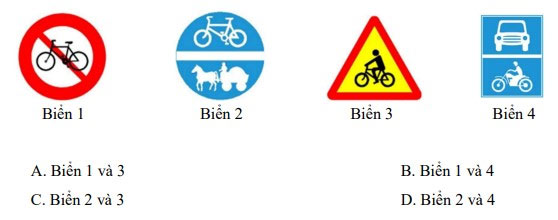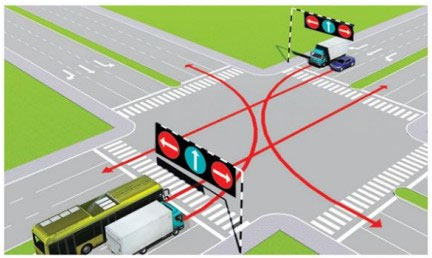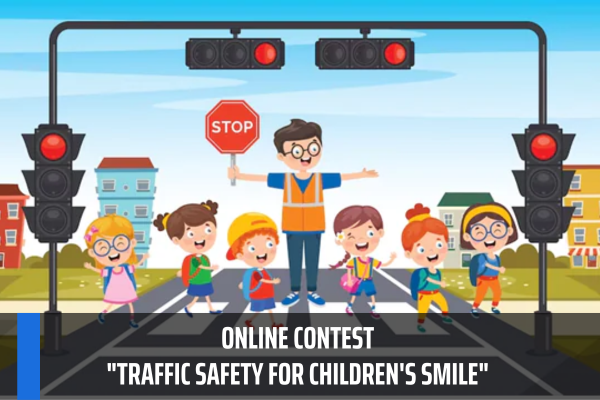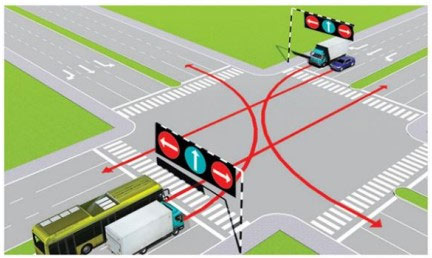What are the answers of the online contest 'Traffic safety for children's smile' of school year 2023-2024 for secondary school students in Vietnam?
- What are the answers of the online contest "Traffic safety for children's smile" of school year 2023-2024 for secondary school students in Vietnam?
- What are the answers of the online contest "Traffic safety for children's smile" of school year 2023-2024 for upper secondary school students in Vietnam?
- What are the policies on road traffic development in Vietnam?
What are the answers of the online contest "Traffic safety for children's smile" of school year 2023-2024 for secondary school students in Vietnam?
Below are the answers to the Online contest "Traffic safety for children's smile" for lower secondary school students for the 2023-2024 school year for students' reference:
Question 1. Which option below is not consistent with road traffic rules?
A. Where there are fixed signs and temporary signs, traffic participants must obey the orders of the temporary signs;
B. Traffic participants must obey the orders and instructions of the road signaling system;
C. When someone is directing traffic, traffic participants must obey the traffic controller's orders;
D. On a one-way road with lane markings, non-motorized vehicles must travel in the left lane, motor vehicles and specialized motorcycles must travel in the innermost right lane.
Question 2. When participating in traffic at night, what should traffic participants pay attention to to ensure the safest?
A. Pay attention to go slowly, carefully observe oncoming vehicles;
B. Pay attention to the sound of car horns and observe car lights;
C. Pay attention to drive slowly, wear light-colored clothes, the vehicle has reflective lights, pay attention to observing vehicle lights and vehicles, and listen to vehicle horns;
D. Go at a normal speed, pay close attention.
Question 3. Choose and fill in the missing word …...about safe walking rules.
“Pedestrians must walk on sidewalks and sidewalks; In case the road does not have sidewalks or sidewalks, pedestrians must walk (1) ………....
Pedestrians can only cross the road in places with (2) ………, road markings or overpasses or tunnels for (3) ………… and must comply with direction signals.
Pedestrians are not allowed to pass (4) ……….., nor cling to moving vehicles; When carrying bulky objects, it must be safe and not cause obstacles to people and vehicles participating in road traffic.
A. (1) on the roadway - (2) median strip - (3) motor vehicle - (4) sidewalk;
B. (1) close to the edge of the road - (2) signal lights - (3) pedestrians - (4) median strip;
C. (1) close to the edge of the road - (2) median strip - (3) traffic participants - (4) lane;
D. (1) on the road - (2) signal lights - (3) non-motorized vehicles - (4) curb.
Question 4. When sitting on the back of a motorbike, how should you sit to ensure safety?
A. Get in the car from the right and sit still in the car;
B. Wrap your arms around the driver;
C. Get on the car from the right side, lightly cling to the driver's side and sit upright, without playing around;
D. Get on the car from the driver's left side, lightly cling to the driver's side and sit upright, do not play around
Question 5. When approaching an intersection with a signal to follow the roundabout, there are many vehicles participating in traffic, how must the driver give way?
A. Must give way to vehicles traveling on the right;
B. The vehicle signaling in front of it can go first;
C. Must give way to vehicles traveling on the left;
D. Only give way to vehicles ahead.
Question 6. Those present at the scene of a road traffic accident have which of the following responsibilities?
A. Quickly leave the scene of a traffic accident;
B. Filming and taking photos to post on social networks for many people to know;
C. Provide information about the accident to friends and relatives;
D. Immediately notify the nearest police, health or People's Committee.
Question 7. Which of the following does not ensure safety when driving in places with obscured visibility?
A. Control speed and be ready to brake when necessary;
B. Always observe safety around you and proactively give way to other vehicles;
C. Always keep a safe distance from the vehicle in front and predict possible bad situations to promptly prevent them;
D. Accelerate quickly to avoid collisions with other vehicles and predict possible bad situations.
Question 8. At level intersections between roads and railways, which of the following vehicles has the right of way?
A. Fire trucks go on duty;
B. Ambulance is performing emergency duty;
C. Special-use cars, motorbikes and motorbikes;
D. Railway transport.
Question 9. Which of the following signs are bicycles not allowed to enter?

Answer: B. Sea 1 and sea 4
Question 10. What order of vehicles in the picture below follow traffic rules?

A. Automobiles, motorbikes, cars, bicycles;
B. Cars, bicycles, motorbikes, auto-rickshaws;
C. Automobiles, cars, motorbikes + bicycles;
D. Motorcycles + bicycles, auto-rickshaws, cars

What are the answers of the online contest "Traffic safety for children's smile" of school year 2023-2024 for secondary school students in Vietnam? (Image from the Internet)
What are the answers of the online contest "Traffic safety for children's smile" of school year 2023-2024 for upper secondary school students in Vietnam?
Question 1: Which of the following actions does not endanger the driver and hinder other traffic participants?
A. Go fast, turn in front of other vehicles;
B. Give a turn signal, watch and turn quickly;
C. Slow down and give turn signal when you want to change direction;
D. Clinging to, pulling or pushing other vehicles on the road.
Question 2. When participating in traffic at an intersection, on the right turn lane with a sagging eye line, how should traffic participants stop if they encounter a red signal light?
A. Traffic participants stop before the stop line;
B. Traffic participants stop before the stop line and are not allowed to stop on the sagging road to give way to vehicles turning at the light signal;
C. Traffic participants stop on the sagging eye line;
D. Traffic participants are allowed to stop on the eye line and wait for the green light to pass.
Question 3. Mr. A is driving an electric motorbike in the town area at the allowed speed. To ensure traffic safety, how much distance should Mr. A keep from the vehicle running right in front of him?
A. Keep a minimum distance of 35 meters;
B. Keep a minimum distance of 55 meters;
C. Actively keep an appropriate safe distance from the vehicle directly in front of your vehicle; This distance depends on vehicle density and actual traffic situation;
D. With appropriate safety distance and smaller than the value written on the sign
Question 4. When driving a vehicle in urban areas and densely populated areas from 10:00 p.m. the previous day to 5:00 a.m. the next day, the vehicle driver (except for priority vehicles) must signal in which of the following ways to ask for permission? overtake a car?
A. Signaling with lights and horns;
B. Signaling by vehicle horn;
C. Signaling by light signals;
D. No need to signal, when you see a wide road, pass quickly.
Question 5: Arrange the steps to safely pass a vehicle when driving an electric motorbike:
(1) Check front and rear safety through the rearview mirror
(2) Check safety again when the vehicle has given way. Increase speed to pass
(3) Turn on the left turn signal to signal a turn and move gradually to the left
(4) Maintain a steady speed behind the vehicle you intend to pass, keeping a safe distance from the vehicle you intend to pass.
A. 2-3-1-4
B. 1-4-2-3
C. 4-3-1-2
D. 4-1-3-2
Question 6. Tomorrow is B's 16th birthday. This afternoon, B asked to borrow his brother's electric motorbike to invite his friend to buy new clothes to wear on his birthday. In your opinion, in this case, how should brother B handle it to ensure compliance with the Road Traffic Law?
A. Resolutely not let B borrow the car;
B. Lending a bike and requiring you to wear a helmet;
C. Lending a bike and not requiring a helmet;
D. Only let B borrow the car and cannot take friends with him.
Question 7. While driving an electric bicycle on the way home from school, M heard the siren of a fire truck behind him. In this case, which of the following options does Mr. M need to drive the vehicle to ensure safety and comply with the Road Traffic Law?
A. Must quickly slow down, avoid or stop close to the right curb to give way to fire trucks;
B. Must quickly increase speed and pass in front to give way to fire trucks;
C. Drive the vehicle at normal speed, avoiding the left side of the road to give way to the fire truck;
D. Immediately stop the vehicle and pull it to the side of the road to give way to the fire truck.
Question 8. Which of the following signs signals a prohibition on vehicles turning left?

A. 1;
B. 1 and 3;
C. 2;
D. 2 and 3
Question 9. Which of the following road markings is the line that separates the two directions of traffic (road center line), vehicles are not allowed to encroach on the lane or overlap the line?

A. 1;
B. 2;
C. 3;
D. 2 and 3.
Question 10. In the picture below, the vehicles are going in the direction of the arrow, which vehicle violates traffic rules?

A. Passenger cars and trucks;
B. Passenger cars and cars;
C. Cars and trucks;
D. Passenger cars, trucks, cars.
What are the policies on road traffic development in Vietnam?
Pursuant to the provisions of Article 5 of the Law on Road Traffic 2008, it clearly states that policies on road traffic development include:
- The State concentrates resources on developing road traffic, prioritizing investment in developing road traffic infrastructure facilities in key economic regions, cities, mountainous, deep-lying, remote, border, island and ethnic minority regions; and adopts policies to mobilize resources for road administration and maintenance.
- The State adopts the policy of prioritizing the development of mass transit and restricting the use of personal vehicles in cities.
- The State encourages and creates conditions for Vietnamese and foreign organizations and individuals to invest in and commercially operate road infrastructure facilities and road transportation activities, and conduct research, apply scientific and technological advances and train human resources in the field of road traffic.
LawNet